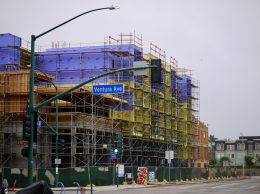Editorial: New redevelopment efforts should learn from RDA era
IN THIS ARTICLE
- Editorials Topic
- Editorial Board Author
By Editorial Board Friday, September 21st, 2012
Gov. Jerry Brown may have dissolved redevelopment agencies across California, but he hasn’t really put an end to the community redevelopment game.
At a breakfast on Sept. 14 at the Reagan Library in Simi Valley, Thousand Oaks City Manager Scott Mitnick described to the Business Times how the formation of a new Infrastructure Financing District might be able to complete some of the city’s now-shelved RDA projects.
In Santa Barbara, city officials are looking at the possibility of using land banked in the RDA era to support workforce housing projects. Modeled on projects such as the Cottage Hospital medium-density program on Santa Barbara’s East side, these are hybrid ownership programs. While homeowners don’t get the full market appreciation in a roaring economy, they do get steady and predictable appreciation of 3 percent to 4 percent per year, plus full tax deductions for interest and property taxes.
Homeowners must sell the property if they leave the area but they do get the comfort of a guaranteed buyer at a guaranteed price with predictable fees. The city of Santa Barbara is expected to provide more details about its plans in the next few months; the plan could be highly attractive to middle class families earning $50,000 to $150,000 per year who still cannot afford an entry-level home or condo.
The biggest problems with both the IFD model or the city of Santa Barbara’s workforce housing plan are regulation and paperwork. These are complicated programs that must move with predictable speed through planning and permitting if they are going to be economically viable. In addition, for a workforce housing program to work, homeowners must have a predictable and timely path to success.
Santa Barbara developer Michael Towbes suggested that one way to speed the process along would be for Cottage to make its real estate documents available to the city for use to replicate in the development of its workforce housing program. Having a set of documents readily available could shave thousands of dollars from the transaction cost involved in developing workforce housing. We’d add that the city should develop a single set of design and construction standards so that projects could be designed to a specific standard and then moved more quickly through planning and architectural review.
Getting the right infrastructure is key for major communities in the region to stay economically vigorous in the 21st century. Getting housing right and at the right price is the key piece to the infrastructure puzzle in housing-short spots such as Santa Barbara, Ventura and SLO.
The key to both is efficiently developing projects where the cost of design and permitting do not substantially undermine the original goal. Policy makers should keep operating efficiencies and overall costs in mind as they reinvent the RDA game.
Ventura housing policy change will help workforce
For those who believe that a free-market approach is the best path forward for housing, the city of Ventura has taken a bold step forward.
The city council has voted to suspend rules requiring multi-family projects to include an affordable housing component — no longer will developers will required to set aside a number of units for subsidized housing when they build apartments and condos.
Affordable housing is typically meant for tenants who fall near or below the poverty line and is distinct from workforce housing. That means the city’s recent decision will make more future units available for working professionals and, theoretically, financing should also be easier.











